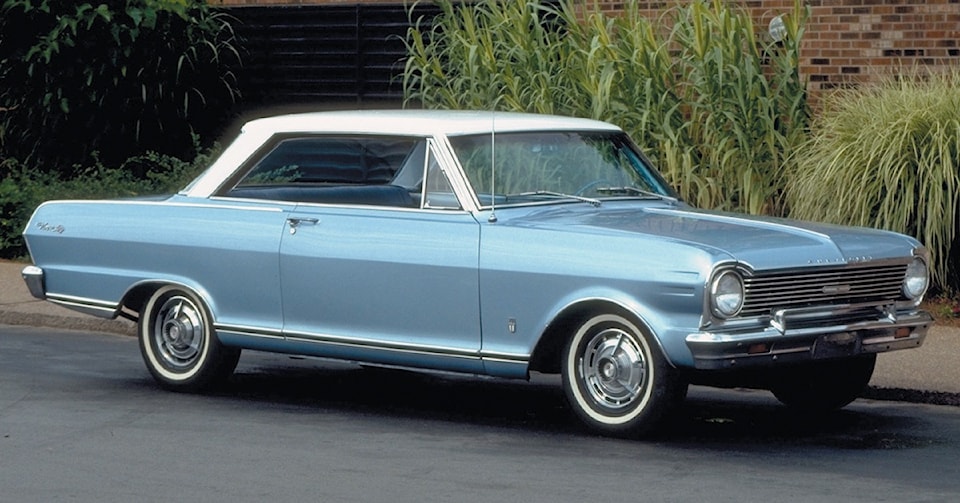Most old-school car guys make no bones about bashing today's four-cylinder models.
"It's not like the days of the 'Cuda, Mustang or Nova," they'll say.
Everyone loves muscle cars, however the first two of those came with six-cylinder base engines and the Nova came with, you guessed it, a fourcylinder. And just 90 horsepower, which is a joke by today's standards.
But old-school car guys have selective memories about humble models, mostly because big muscle makes the best stories.
As much as they're the stuff of legends, Hemicudas/SS 454 Chevelles/GT 500 Mustangs didn't rule the road because there just weren't enough of them built.
No, what you were more apt to see were tamer six-cylinder models or base V8 cars.
The 1968-'72 Novas (Chevy II for 1968) were for the most part unglamorous breadand-butter grocerygetters that lacked the pedigree of the cars so passionately pampered and drooled over at today's car shows.
They don't fetch big bucks at auctions and necks seldom snap even when a pristine example cruises by.
The vast majority of Novas sold had four doors and/or were powered by thrifty six-cylinder engines. A four-cylinder was offered until 1970.
They were part of Chevy's compact-car family whose first duty was to provide A-to-B transportation. What more did it need to do? Chevrolet already had its powerhouse Camaro and curvaceous Chevelle.
Like so many other cars of the day, however, the Nova was transformed into a stout performer that, although not the huge sales success of its siblings, had more than enough charm to earn "they-don't-make-'emlike-that-anymore" comments.
Originally built to do battle with Ford's Falcon, the Chevy II, as it was called, was in need of a remake to keep up with the times and stem a decline in sales. This took place for 1968.
Borrowing the floorpan, forward subframe and most suspension pieces from the Camaro and the semi-fastback look of the Chevelle, the new Chevy II Nova, in two-door livery, might best be described as the offspring of the two platforms.
As a bonus, the Nova's front/rear weight balance was better than the Camaro's, and the minimalist, all-business styling was refreshing in a day and age when stripes, cartoon characters and other gimmicks were part and parcel of what the hip, high-profile buying public wanted.
So, why does this car qualify for "Fine Lines" status? The Nova, as history would reveal, was one of the most honest and hardworking cars available at the time.
The fact that it did triple duty as a thrifty family hauler, sporty two-door and youthful muscle machine only bears this out.
For 1968, the first year of the remake, sales approached the 200,000 mark. Only 1,270 came with the 90-horsepower four-cylinder while about 130,000 came with the six-cylinder engine.
Nearly 50,000 V8-powered Novas were sold and came equipped with everything from a 283, 307, 327, 350 and the 396 big block at the top.
The 1968 base price for a V8-powered Chevy II Nova was less than $2,400 and was the key carrot dangling in front of the noses of prospective buyers.
For just $210 more, the SS package included such goodies as special badging, black-accented grille, special hood ornaments, insignia and 70-series rubber.
Still, you had to pay more money to replace the hub caps with road wheels. The 295-horsepower (later upgraded to 300) 350 OHV V8 was mandatory motivation if you wanted to SS-ize your Chevy II Nova. Of course, you could upgrade to one of two versions of the powerhouse 396, rated at 350 and 375 horsepower.
Despite the paltry SS entry fee, only 5,600 buyers stepped up to purchase the package, making any '68 Chevy II Nova SS rare, especially today, four decades after creation. Only 900 carried the 396.
Despite minor cosmetic variations, the Nova (the Chevy II name was dropped for 1969) marched right through to 1970 relatively unfettered. The 396 actually displaced 402 cubic inches, but was called a 396 so that it wouldn't be confused with the 400 "small block" that was also being built.
Word of the SS was out as more than 17,000 were ordered for 1969. And nearly 20,000 hit the streets for 1970.
As with all hot cars of the day, 1971 was the beginning of the performance downturn. The 350 was downrated to 270 horsepower and the 396 engines were conspicuously absent.
The decline in the performance market that clobbered the sales of other factory hot rods seemed to only strengthen the resolve of a public that needed to have cheap, fuel-efficient transportation. As a result, sales of the Nova rocketed to nearly 350,000 units in 1972, while SS production dropped to about 12,000 cars.
Even rated at 200 "net" horsepower (the old system of "gross" ratings without any power-robbing engine accessories was gone as it was deemed less realistic), the base SS 350 was no slouch and contained all the equipment available the year before.
After 1972, it's safe to say that the gnarly Nova SS was gone, certainly in terms of soul.
The SS package became cakedressing with little in the way of performance hardware. Parading around in pseudo-supercar garb for a couple more years did nothing to further the image of the marque.
Still, the Nova did its job as close to one million examples of the popular compact were built and sold between 1968 and '72.
Although it might not be one of the most sought after and talked about cars when the topic of landmark vehicles and milestones ensues, it was very typical of what Joe or Jane Average were buying and, for that reason, takes it rightful place in halls of automobile history, even if it doesn't as a conversation piece around the shop.
